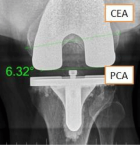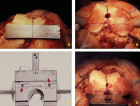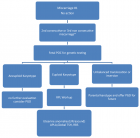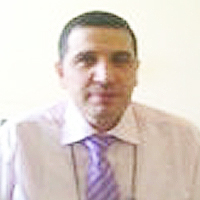Abstract
Research Article
‘Rotational alignment on patients’ clinical outcome of total knee arthroplasty: Distal femur axillary X-ray view to qualify rotation of the femoral component
S Magersky*
Published: 04 May, 2020 | Volume 5 - Issue 2 | Pages: 008-011
Background: Rotation of the femoral component in total knee replacement (TKR) is very important for good long-term results. Malrotation of the femoral component usually requires subsequent reimplantation. We performed X-ray projections of the knee at 90° to determine proper rotation of the femoral component without use of computed tomography.
Methods: The axial projection of the distal femur was measured in post-TKR cases. During the TKR operation, Whiteside’s method had been used to provide symmetrical flexion space. The exact outer rotation of the femoral component was measured by x-ray determination of the middle condylar twist angle, from the central epicondylar axis and posterior condylar axis.
Results: The middle condylar twist angle was in outer rotation, with an average of 3.36° (range: 1-7.6), similar to the literature. Six of the patients underwent bilateral TKR. In total, the case series included 18 women and 15 men, with average age of 71.34 years-old (range: 56-85). As a clinical evaluation we used Knee Society Score (2011). From results 2 patients were not very satisfied with the instability TKR. Axially X-ray seemed to be only which could distribute these patients.
Summary: X-ray values have the same evaluation as computed tomography. The results were 2 patients in pattern of 48, which were sufficient to extrapolate to whole population according to the statistical methods. This corresponds to 4% which we can add to evaluate satisfaction of all patients after TKR and eventually lower the total of unsatisfactory patients which is total of ¼ of total. It is also forensic reason for all patients. Our recommendation to have good results and patient satisfaction in TKR is to do x-rays before and after operation. Important are x-rays antero-posterior, lateral, and Kanekasu projection to know the rotation after TKR. Other cases without stability in flexion are nor very rarely planed for revision surgery, which is much more expensive, and burdens overall health system.
Read Full Article HTML DOI: 10.29328/journal.jsmt.1001050 Cite this Article Read Full Article PDF
Keywords:
Arthroplasty; Malrotation; Total knee replacement
References
- Rodrics DJ, Patil P, Cowell Jr CW. Press-fit condaylar design total knee artroplasty. Fourteen to seventeen-year follow up. J Bone Joint Surg Am. 2007; 89: 89-95. PubMed: https://www.ncbi.nlm.nih.gov/pubmed/17200315
- Hernandez-Vaquero D, Noriega-Fernandez A, Fernandez-Carreira JM, Fernandez-Simon JM, Llorens de los Rios J. Computer-assisted surgery improves rotational positioning of the femoral component but not the tibial component in total knee arthroplasty. Knee Surg Sports Traumatol Arthrosc. 2014; 22: 3127–3134. PubMed: https://www.ncbi.nlm.nih.gov/pubmed/25155048
- Scott CE, Howie CR, MacDonald D, Biant LC. Predicting dissatisfaction following total knee replacement: a prospective study of 1217 patients. J Bone Joint Surg Br. 2010; 92: 1253–1258. PubMed: https://www.ncbi.nlm.nih.gov/pubmed/20798443
- Lombardi Jr AV, Berend KR, Adams JB. Why knee replacements fail in 2013: patient, surgeon, or implant? Bone Joint J. 2014; 96-B(11 Supple A): 101–104. PubMed: https://www.ncbi.nlm.nih.gov/pubmed/25381419
- Sharkey PF, Lichstein PM, Shen C, Tokarski AT, Parvizi J. Why are total knee arthroplasties failing today—has anything changed after 10 years? J Arthroplasty. 2014; 29: 1774–1778. PubMed: https://www.ncbi.nlm.nih.gov/pubmed/25007726
- Franceschini V, Nodzo SR, Gonzalez Della Valle A. Femoral component rotation in total knee arthroplasty: a comparison between Transepicondylar Axis and posterior condylar line referencing. J Arthroplasty. 2016; 31: 2917–2921. PubMed: https://www.ncbi.nlm.nih.gov/pubmed/27374639
- McDougall CJ, Gallie P, Whitehouse SL. Preoperative assessment of femoral rotation and its relationship with coronal alignment: a magnetic resonance imaging study. J Orthop. 2016; 13: 290–293. Y. PubMed: https://www.ncbi.nlm.nih.gov/pubmed/27408506
- Victor J. Rotational alignment of the distal femur: a literature review. Orthop Traumatol Surg Res. 2009; 95: 365–372. PubMed: https://www.ncbi.nlm.nih.gov/pubmed/19592323
- Howell SM, Papadopoulos S, Kuznik KT, Hull ML. Accurate alignment and high function after kinematically aligned TKA performed with generic instruments. Knee Surg Sports Traumatol Arthrosc. 2013; 21: 2271–2280. PubMed: https://www.ncbi.nlm.nih.gov/pubmed/23948721
- Nam D, Lin KM, Howell SM, Hull ML. Femoral bone and cartilage wear is predictable at 0 degrees and 90 degrees in the osteoarthritic knee treated with total knee arthroplasty. Knee Surg Sports Traumatol Arthrosc. 2014; 22: 2975–2981. PubMed: https://www.ncbi.nlm.nih.gov/pubmed/24839078
- Kobayashi H, Akamatsu Y, Kumagai K, Kusayama Y, Aratake M, et al. Is the surgical epicondylar axis the center of rotation in the osteoarthritic knee? J Arthroplasty. 2015; 30: 479–483. PubMed: https://www.ncbi.nlm.nih.gov/pubmed/25466167
- Aunan E, Østergaard D, Meland A, Dalheim K, Sandvik L. A simple method for accurate rotational positioning of the femoral component in total knee arthroplasty. Acta Orthop. 2017; 11: 1–7. PubMed: https://www.ncbi.nlm.nih.gov/pubmed/28799446
- Akagi M, Yamashita E, Nakagawa T, Asano T, Nakamura T. Relationship between frontal knee alignment and reference axes in the distal femur. Clin Orthop Relat Res. 2001; 388: 147–156. PubMed: https://www.ncbi.nlm.nih.gov/pubmed/11451114
- Kanekasu K, Kondo M, Kadoya Y. Axial radiography of the distal femur to asses rotational alignment in total knee artroplasty. Clin Orthop Relat Res. 2004; 434: 193-197. PubMed: https://www.ncbi.nlm.nih.gov/pubmed/15864052
- Noble PC, Scuderi GR, Brekke AC, Sikorskii A, Benjamin JB, et al. Development of a new Knee Society scoring system. Clin Orthop Relat Res. 2012; 470: 20-32. PubMed: https://www.ncbi.nlm.nih.gov/pubmed/22065240
- Scuderi GR1, Bourne RB, Noble PC, Benjamin JB, Lonner JH, et al. The new Knee Society knee scoring system. Clin Orthop Relat Res. 2012; 470: 003-019. PubMed: https://www.ncbi.nlm.nih.gov/pubmed/22045067
Figures:

Figure 1

Figure 2

Figure 3

Figure 4
Similar Articles
-
‘Rotational alignment on patients’ clinical outcome of total knee arthroplasty: Distal femur axillary X-ray view to qualify rotation of the femoral componentS Magersky*. ‘Rotational alignment on patients’ clinical outcome of total knee arthroplasty: Distal femur axillary X-ray view to qualify rotation of the femoral component. . 2020 doi: 10.29328/journal.jsmt.1001050; 5: 008-011
-
Effects of Physiotherapy Care in the Postoperative of Total Hip Arthroplasty: An Integrative ReviewWeslley Barbosa Sales*, Rômulo Claudino Sales e Rodrigues Costa, José Vinicius Bulhões da Silva. Effects of Physiotherapy Care in the Postoperative of Total Hip Arthroplasty: An Integrative Review. . 2024 doi: 10.29328/journal.jsmt.1001077; 9: 022-026
Recently Viewed
-
Precessional Motion Emerging from Relativistic Component of External ForceJanusz Wolny, Radosław Strzałka*, Ireneusz Bugański. Precessional Motion Emerging from Relativistic Component of External Force. Int J Phys Res Appl. 2024: doi: 10.29328/journal.ijpra.1001100; 7: 148-153
-
The incidence of hemodynamic and respiratory adverse events in morbidly obese presenting for Bariatric surgeryTomi Myrberg*,Veronica Atterhem,Magnus Hultin . The incidence of hemodynamic and respiratory adverse events in morbidly obese presenting for Bariatric surgery. Int J Clin Anesth Res. 2018: doi: 10.29328/journal.ijcar.1001006; 2: 009-017
-
Deciphering the Rosetta Stone - Trans-Mitral Doppler Patterns for a Simplified Study of Left Ventricular Systolic DysfunctionGeorge Thomas*. Deciphering the Rosetta Stone - Trans-Mitral Doppler Patterns for a Simplified Study of Left Ventricular Systolic Dysfunction. Int J Clin Anesth Res. 2023: doi: 10.29328/journal.ijcar.1001023; 7: 008-011
-
Euthanasia: Growing Acceptance amid Lingering ReluctanceTshibambe N Tshimbombu,Immanuel Olarinde,Judea Wiggins*,Maxwell Vergo. Euthanasia: Growing Acceptance amid Lingering Reluctance. Clin J Nurs Care Pract. 2025: doi: 10.29328/journal.cjncp.1001058; 9: 001-006
-
Community, health and rehabilitationAlessandro Giustini*. Community, health and rehabilitation. J Community Med Health Solut. 2023: doi: 10.29328/journal.jcmhs.1001025; 4: 001-003
Most Viewed
-
Evaluation of Biostimulants Based on Recovered Protein Hydrolysates from Animal By-products as Plant Growth EnhancersH Pérez-Aguilar*, M Lacruz-Asaro, F Arán-Ais. Evaluation of Biostimulants Based on Recovered Protein Hydrolysates from Animal By-products as Plant Growth Enhancers. J Plant Sci Phytopathol. 2023 doi: 10.29328/journal.jpsp.1001104; 7: 042-047
-
Sinonasal Myxoma Extending into the Orbit in a 4-Year Old: A Case PresentationJulian A Purrinos*, Ramzi Younis. Sinonasal Myxoma Extending into the Orbit in a 4-Year Old: A Case Presentation. Arch Case Rep. 2024 doi: 10.29328/journal.acr.1001099; 8: 075-077
-
Feasibility study of magnetic sensing for detecting single-neuron action potentialsDenis Tonini,Kai Wu,Renata Saha,Jian-Ping Wang*. Feasibility study of magnetic sensing for detecting single-neuron action potentials. Ann Biomed Sci Eng. 2022 doi: 10.29328/journal.abse.1001018; 6: 019-029
-
Physical activity can change the physiological and psychological circumstances during COVID-19 pandemic: A narrative reviewKhashayar Maroufi*. Physical activity can change the physiological and psychological circumstances during COVID-19 pandemic: A narrative review. J Sports Med Ther. 2021 doi: 10.29328/journal.jsmt.1001051; 6: 001-007
-
Pediatric Dysgerminoma: Unveiling a Rare Ovarian TumorFaten Limaiem*, Khalil Saffar, Ahmed Halouani. Pediatric Dysgerminoma: Unveiling a Rare Ovarian Tumor. Arch Case Rep. 2024 doi: 10.29328/journal.acr.1001087; 8: 010-013

HSPI: We're glad you're here. Please click "create a new Query" if you are a new visitor to our website and need further information from us.
If you are already a member of our network and need to keep track of any developments regarding a question you have already submitted, click "take me to my Query."





















































































































































